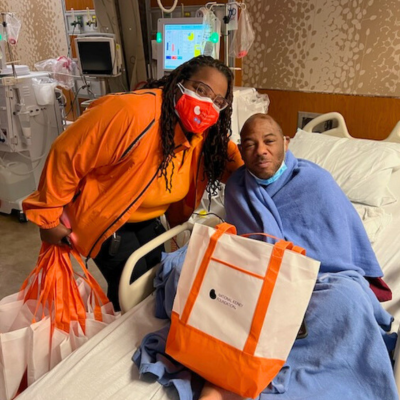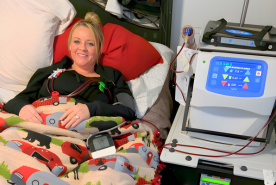May 13, 2025
Discover how hospice care helps people with kidney failure manage pain and find peace without dialysis or transplant.
Another Option
Dialysis or transplantation isn’t always the approach a person with kidney failure chooses to take. For others, these treatments are not an option. When treatment no longer enhances quality of life, hospice gives comfort, dignity, and compassionate support in a person’s final months of life.
What does that look like for someone with kidney failure? For kidney advocate Sarah Hicklin’s mother, hospice allowed her to regain a sense of control after losing it to kidney failure.
What is Hospice?
Hospice is a specialized type of care for people with a life expectancy estimated at six months or less.
People can stay in hospice if they live longer. They can also move out of hospice if their condition improves or they no longer want to be in a hospice program.
Hospice services include:
- Pain and symptom management
- Emotional and spiritual support
- Assistance with daily tasks like hygiene, dressing, and feeding
- Counseling for patients and families
- Bereavement support
- Dietary guidance, including when to stop nutrition support.
People with kidney failure can use hospice care if they decide to stop or not start dialysis. This leads to a natural decline in health, resulting in death.
Common reasons for stopping dialysis include:
- Declining quality of life
- Other serious health conditions, like cancer or advanced heart disease
- Limited medical benefits of continued dialysis
- Loss of independence
- Complications with dialysis access
People who stop dialysis may live from a few days to several weeks, depending on their remaining kidney function and overall health.
A Personal Journey: Choosing Comfort Over Treatment
Sarah's mother was diagnosed with kidney disease when she was 55.
"She started peritoneal dialysis (PD), a form of dialysis that uses a catheter, the lining of the abdomen, and a fluid called dialysate," Sarah explained. "It performs the kidneys' functions, cleaning out toxins and balancing fluids."
Her mom’s treatment was successful for seven years. Then, she began experiencing severe infections in the catheter.
"She had to switch to in-center hemodialysis. She couldn't have a fistula for hemodialysis because her veins were too small,” Sarah said. “She got a catheter in her neck instead."
This form of dialysis wasn't comfortable. Worse still, the catheter frequently clogged and needed replacing.
"The last time she ended up in the hospital with a catheter clot, she asked about other treatment options. She was never interested in transplantation but would have considered it at this point,” said Sarah. “But her health was too poor. Her only other choice was stopping dialysis."
Sarah's mother took a week to make her decision. She spoke with mental health counselors, her healthcare team, and her family.
"We learned that she'd likely be fine in the first week after quitting dialysis. During the second week, she'd sleep more and may feel ill from toxins building up,” Sarah said. “She'd sleep most of the third week before passing away."
Sarah's mother decided to stop dialysis since death was going to be relatively painless. She was coherent for about three weeks before slipping into a coma. She passed three days later, surrounded by her loved ones.
"One of the hardest things for my mother was losing control over her life,” said Sarah. “When she decided to stop dialysis, she regained that control. I'll never forget when she realized she could eat whatever she wanted—she asked me to get her some really good bologna from the deli. She truly enjoyed that sandwich."
Subscribe today!
Join the NKF Blog Newsletter
Get inspirational stories and kidney disease resources delivered to your inbox every month. You'll gain practical insights and expert advice to help you better understand and manage your kidney health, no matter where you are on your kidney journey.
How to Get Hospice Care
If you or a loved one is considering hospice care for kidney failure, the first step is to speak with your healthcare provider. They will help determine whether you or your loved one qualifies for hospice.
How to get hospice care:
- Talk to Your Doctor: Discuss your treatment options early. Ask when hospice is appropriate and how to discuss it with family and friends.
- Find a Hospice Provider: Many hospitals, home health agencies, and nonprofit organizations offer hospice services. Medicare, Medicaid, and most private insurances cover hospice care.
- Schedule an Assessment: Get evaluated by the hospice care team.
- Enroll and Begin Services: Once enrolled, the hospice team will provide medical care, emotional support, and practical assistance to ensure comfort and dignity.
Hospice services can be provided at home, a nursing facility, or a specialized hospice center.
Stopping or Not Starting Dialysis
Choosing to stop or not start dialysis is a deeply personal decision that should be made with guidance from healthcare professionals, counselors, and loved ones. If you or a loved one is considering this option, talk with a hospice provider to understand the support available.










